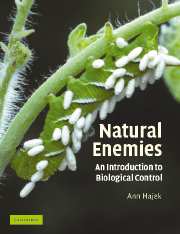Book contents
- Frontmatter
- Contents
- Preface
- Acknowledgments
- Introduction
- PART I Strategies for using natural enemies
- PART II Biological control of invertebrate and vertebrate pests
- Chapter 6 Ecological basis for use of predators, parasitoids, and pathogens
- Chapter 7 Predators
- Chapter 8 Insect parasitoids: attack by aliens
- Chapter 9 Parasitic nematodes
- Chapter 10 Bacterial pathogens of invertebrates
- Chapter 11 Viral pathogens
- Chapter 12 Fungi and microsporidia
- PART III Biological control of weeds
- PART IV Biological control of plant pathogens and plant parasitic nematodes
- PART V Biological control: concerns, changes, and challenges
- Glossary
- References
- Index
Chapter 7 - Predators
Published online by Cambridge University Press: 05 June 2012
- Frontmatter
- Contents
- Preface
- Acknowledgments
- Introduction
- PART I Strategies for using natural enemies
- PART II Biological control of invertebrate and vertebrate pests
- Chapter 6 Ecological basis for use of predators, parasitoids, and pathogens
- Chapter 7 Predators
- Chapter 8 Insect parasitoids: attack by aliens
- Chapter 9 Parasitic nematodes
- Chapter 10 Bacterial pathogens of invertebrates
- Chapter 11 Viral pathogens
- Chapter 12 Fungi and microsporidia
- PART III Biological control of weeds
- PART IV Biological control of plant pathogens and plant parasitic nematodes
- PART V Biological control: concerns, changes, and challenges
- Glossary
- References
- Index
Summary
Use of invertebrate versus vertebrate predators has been strikingly different and these predators themselves have very different attributes. Therefore, these different types of predators will be discussed separately.
Vertebrate predators
Vertebrate predators are better known to the general public than most invertebrate predators. However, the days for use of vertebrates for biological control are largely over; the prey of vertebrate predators is too unpredictable. Vertebrates are more complex and have a more varied repertoire of behaviors than invertebrates. They can learn in a new environment and switch to new types of prey. However, exactly because vertebrate predators were larger and more obvious, they were used for early biological control introductions. For example, as long ago as 1762, mynah birds, Acridotheres tristis, from India were introduced against red locusts, Nomadacris septemfasciata, on Mauritius, an island in the Indian Ocean. In 1872, the small Indian mongoose, Herpestes javanicus, was introduced from India to Trinidad to control rats in sugar cane. The activity of these voracious predators was said to prevent UK£45,000 of losses in sugar production, an enormous sum at that time. Unfortunately, this early introduction went on to demonstrate the potential problems of introducing vertebrates. The mongoose was predominantly active during the days and rats were active at night. The mongoose became a pest after they quickly learned to kill chickens and the native ground-dwelling lizards and ground-nesting birds. In another disastrous introduction, the cane toad, Bufo marinus, was introduced from northern South America into the Caribbean and then Australia to control scarab larvae infesting sugar cane.
- Type
- Chapter
- Information
- Natural EnemiesAn Introduction to Biological Control, pp. 124 - 144Publisher: Cambridge University PressPrint publication year: 2004



